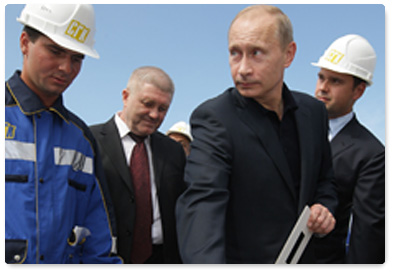
Gazprom Targets Larger Share of the U.S. Energy Market
Publication: Eurasia Daily Monitor Volume: 6 Issue: 169
By:

On July 31 the Russian Prime Minister Vladimir Putin formally launched the construction of the new strategic 1,800 kilometer Sakhalin-Khabarovsk-Vladivostok natural gas pipe-line, which is designed to ensure exports to the Asian Pacific Region (APR) from a new Liquefied Natural Gas (LNG) plant to be built in Vladivostok (EDM, August 11).
The key market that Gazprom targets in the ATR is the United States. On June 8, Alexander Medvedev, Gazprom Deputy CEO and Gazpromexport Director revealed Gazprom’s ambitions to take over at least 10 percent of the U.S. natural gas market by tanker-supplied LNG (Vedomosti, June 9). In fact, Gazprom has been steadily pursuing these ambitions since 2005, when the first LNG-carrying tanker docked at Cove Point, Maryland. In 2007, Medvedev announced his plans to access a sizable segment of the U.S. market (www.gazeta.ru, December 4, 2007).
Now, Russia’s economic crisis and shrinking production of gas notwithstanding, Gazprom is out to secure a piece of the American market in the way it has acted in Europe. Should the U.S. allow that to happen, it might become subject to the same kind of Russian gas blackmail which has been experienced in Europe. "LNG is not a pipeline," wrote the Russian internet daily Gazeta.ru in 2007. "Tankers can easily be turned around and dispatched to another customer" (www.gazeta.ru, December 4, 2007).
Indeed, even European customers who are receiving Russian supplies via its pipelines know how suddenly these supplies can dry up during a severe winter. Since January 2005, when Ukraine was the first to taste Moscow’s anger, as Gazprom turned off the gas, many European countries suffered gas shortages. In January 2009 Bulgaria, Greece, Macedonia, Romania, Croatia, Serbia and Turkey all reported a halt in gas shipments, while France, Germany, Austria, Poland and Hungary reported substantial drops in supplies from Russia. Tens of thousands of people were left without heat and governments scrambled to find alternate energy sources (Associated Press, January 6).
Slovakia and Bulgaria were hit particularly badly. In fact, Bulgaria, heavily reliant on Russian gas, almost froze last January in the middle of a particularly cold winter. Russia, enraged with Ukraine’s ambitions of joining the European Union and NATO, was cowing Ukraine into political submission, using its energy resources as a political tool. "This situation is completely unacceptable," said European Commission spokesman Johannes Laitenberger (Associated Press, January 6).
The European Commission strongly recommended that all members of the European Union urgently start looking for ways to diversify their natural gas suppliers. Meanwhile, the commission also suggested that as a short-term solution, all E.U. members should fill their natural-gas storage facilities to capacity to be prepared for any new natural gas cutoffs from Russia. The U.S. shared the E.U. position at the time. "This episode underscores the critical need to diversify sources of natural gas, as well as other energy supplies," said U.S. State Department spokesman Sean McCormack (Associated Press, January 6).
Now, however, "If Russia’s Kremlin-controlled energy monopoly Gazprom gets its way, such emergency measures may also become a reality in the United States," warned The Washington Times (The Washington Times, July 31). It noted that "Gazprom’s share in the U.S. market now stands at about 0.5 percent, a proportion that could be made up quickly by domestic or Canadian reserves should it be cut off. But a 10 percent share could not be made up in a timely fashion, and could present Kremlin decision-makers with significant leverage over Washington. Before we scold our European allies for an addiction to Russian gas, we ought to coldly assess our own future sources" (The Washington Times, July 31).
Gazprom also seeks further expansion in Europe. On June 29, Gazprom’s CEO Alexei Miller told the annual stockholders’ meeting that by 2011 Gazprom plans to take over 10 percent of Britain’s gas market. Currently, Gazprom’s daughter Gazprom Marketing & Trading (GM&T) accounts for some 8 percent of the British gas market. Originally, GM&T entered the U.K. gas market in 2006 by buying the supply businesses of privately-owned Pennine Natural Gas Ltd (www.forbes.com, June 22, 2006). Then, Gazprom added other piecemeal acquisitions. In April 2006, Gazprom also completed its first shipment of LNG to Britain (www.sg.biz.yahoo.com, April 12, 2006).
Authoritative experts, such as Mikhail Krutikhin of Rusenergy, a key Russian think tank on energy issues, are skeptical about Gazprom’s ambitious plans. "Propaganda is one of Gazprom’s established ways of operating," he recently observed (www.bbc.co.uk, June 9). Krutikhin told Jamestown: "Indeed, the share of Russian gas in Europe used to cover some 33 percent of demand. Now, it does not amount to more than 25percent." Like many other experts, Krutikhin does not see where Gazprom can find sufficient reserves to ensure contracted supplies, let alone enter new market ventures.
The answer, however, easily presents itself, Krutikhin suggested: even if Gazprom does not have sufficient reserves of its own, it always can supply Britain and the U.S. with LNG appropriated from U.S. and other Western companies, like ExxonMobil, Shell, BP, etc. All those, in fact, who have ventured into the Russian market in search of quick profits, and now cannot disengage. Indeed, what could be sweeter for the Kremlin than blackmailing the United States with assets, appropriated from U.S. business?




